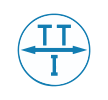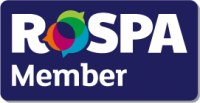** Exciting New Optimoor Developments **
TTI’s in house developed OPTIMOOR program is one of the World’s leading and most trusted mooring analysis software packages. With capabilities to model Static, Dynamic, Wave Response, Ship-to-Ship, Tsunami, Passing Ships, and many other features.
The TTI Optimoor development team are continuously looking to enhance the programmes capabilities both behind the scenes and to provide a user desktop interface that meets the requirements of today’s demands. As part of these requirements TTI has been working on the development of a 3D interface model and we are excited to share a preview of what is coming down the pipeline.
The 3D model is an interactive world where the user interface provides complete customisation of the vessel and moorings all in 3D. The vessel and mooring equipment are all plastic and the model will automatically adjust to users input parameters dynamically solving mooring forces.
Proximity tests and ruler measurements via point and click gives immediate feedback for any potential clashes of mooring lines and jetty structure.
Other features to be provided include:
Full customisation of vessel and berth dimensions.
Vessel and Berth drawings import and overlay.
Custom branding
Follow the link below for the promotional video and email us at optimoor@tensiontech.com to ensure you receive the lastest news from us on this exciting development.
Optimoor - Mooring Analysis Software
OPTIMOOR is an easy-to-use mooring analysis computer program for use by vessel and terminal personnel as well as by port designers and naval architects. It is based on the Oil Companies International Marine Forum (OCIMF) recommendations and procedures and includes OCIMF wind and current coefficients for tanker and gas carrier (prismatic / moss) vessels.
OPTIMOOR is a now a large comprehensive and powerful software package that can model Static, Dynamic, Wave Response, STS (See example video), CBMs, SPMs, turret, tower Yoke, collars, spread moorings, load out, passing ship (see video example videos Passing ship -Winches Rendering & Broken Lines), LNG Bunkering etc.
OPTIMOOR is a Windows program that runs on all versions including lastest versions of Windows 10.
OPTIMOOR can be used to plan a vessel's mooring arrangement and to assess the adequacy of a terminal's mooring facilities. It can be used to train personnel in how to plan the optimum mooring layout and to react to different weather conditions. Time will then be saved in deploying lines to the proper mooring points. Graphic overlay of the vessel deck layout provides verification of the vessel file and easy view of which lines run to drums and/or bitts and mooring dolphins. Also, graphic overlay of aerial images or photographs like Goole Earth is useful to verify the berth. (See example video)
At terminals, OPTIMOOR can be used to assess the adequacy of vessel mooring equipment for the terminal mooring arrangement. The need for and effectiveness of auxiliary mooring lines can be judged. Wind or current limitations can otherwise be imposed. Tide tables can be input in advance and then used to anticipate line tending requirements.
Vessel owners and operators can use OPTIMOOR to check the adequacy of vessel mooring equipment placement on new and existing vessels. It can help determine if vessels can be safely moored at various terminals, and if special limitations are necessary.
A key feature in mooring analysis using OPTIMOOR is that it models both quasi-static and dynamic rope stiffness automatically - no further entry of data is required
Other Key Features Include
- All types of inshore and offshore ship moorings
- Shielding effect of piers
- In-built OCIMF methods and wind/current drag coefficients
- Easy reporting to RTF format, wind/wave roses
- Graphic plan with “drag & drop” moorings
- Toggle between Metric and Imperial units
- Time related analyses to account for vessel draft (loading) and tide level changes
- Single and multiple batch files
- Easy reporting to Word and Excel files
- Auto generation of wind or wave capability rosette
- Fixed piers with catenary anchored buoys
- Option to lock vessel/berth data
- Comprehensive rope property database, both static and dynamic stiffness modelled
- Auto or manual pre-tension to set up mooring
- Wave Response Module [WRM] Option
- Ship2Ship Option for side by side mooring
(OCIMF) Mooring Equipment Guidelines (MEG4), 2018 requires ships to designed with adequate mooring equipment for winds of 60 knots from any direction simultaneously with either: 3 knots of current ahead or astern, or 2 knots of current from 10 degrees off bow or stern quarter, or 0.75 knots current from the direction of maximum beam current loading.
Hand calculation of the various applied and resulting forces, using methods described in several OCIMF documents, is difficult and time consuming, and the results of such hand calculations are only approximations. Computer simulation has in the past been the work of specialists, and was time consuming and expensive. OPTIMOOR is a simple program, employing the methods and formulae recommended by OCIMF, in a manner that can be run even by non-technical personnel.
Within OPTIMOOR, descriptions of the vessel mooring gear and arrangement and the placement of terminal mooring points are prepared on simple "spread sheets". Another "spread sheet" is then used to describe the mooring line arrangement of the vessel at the berth. The wind and current velocities and directions are then input to analyze the mooring system, by calculating mooring line loads and vessel motion. These calculations are carried out instantaneously whenever input data is changed.
Lines that are loaded more than 50% for synthetics or 55% for steel of LDBL (Line Design Break Load) are highlighted in red. A plan view of the mooring can be viewed to check the mooring line arrangement and the mooring load analysis can be printed for records and later study.
Functions and commands are intentionally simple in OPTIMOOR. One key command brings the case back to its initial conditions and resets target pre-tensions. Another brings all lines up to the tension that provides the least vessel movement. The user may then alter tensions in mooring lines by a simple process analogous to tending the mooring winch to bring the mooring line load distribution into better balance. A key command sweeps the wind through 360 degrees to determine the "worst-case" loading on each line.
OPTIMOOR has provision for input of initial and final draft and trim conditions and times. It also has provision for tide tables and local correction factors and even for tidal currents. Line tending requirements can then be anticipated by stepping forward in time by minute or hour intervals. Also, one key command "fast-forwards" and displays the times at which various lines will be overloaded.
OPTIMOOR minimises the need for the user to gather, calculate, and input other data, relating to wind and current forces and mooring line strengths and elasticities.
A data base of wind and current coefficients includes (under license) the OCIMF wind and current data. OPTIMOOR calculates vessel windage areas based on the vessel size and the present draft and trim. It then calculates the forces and moments applied by the specified wind and current. Other forces, for example tugs, ice, passing ship can also be applied.
OPTIMOOR includes the approximate new breaking strength and load-extension characteristics for mooring lines. Data is provided for wire, Aramid/HMPE, nylon double braid, nylon plaited and stranded, polyester, and polypropylene. Broken-in characteristics for the synthetic ropes are provided, based on TTI and OCIMF test data. Synthetic tails (were used) on the ends of mooring lines are also included.
OPTIMOOR considers the on-deck length and vertical angle of mooring lines in its calculations. It calculates effects of fairlead and bollard elevations relative to vessel and pier decks. Where applicable, winch brake limits can be set and if exceeded will pay out rope.
OPTIMOOR is available in three versions: "Standard" which analyses moorings at piers and sea islands. "Plus" which also analyses moorings at offshore spread moorings utilising buoys and catenaries and "Dynamic" which models time domain. Additional modules available to any of the 3 versions include, 'WRW' Wave response Module which models 1st order wave motions and 2nd order drift forces and "S2S" for two ships at any type o mooring i.e. yoke, collar, spread, turret, CBM.
SOFTWARE | OPTIMOOR
YOU ARE IN SOFTWARE

/NQA-ISO-9001-Logo-UKAS.jpg)
